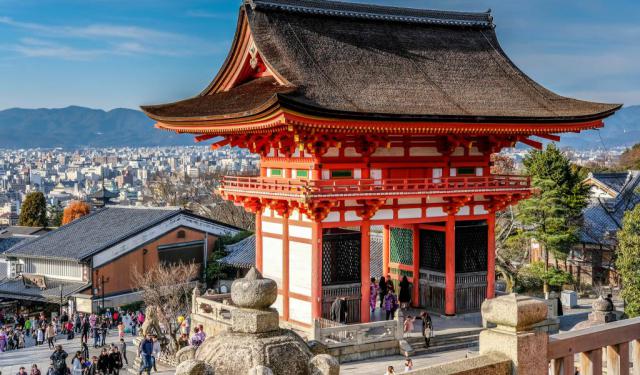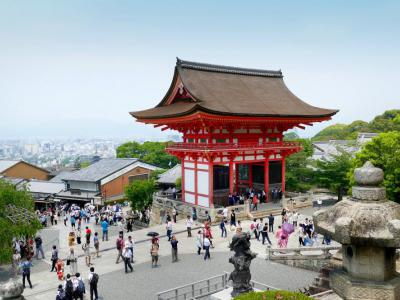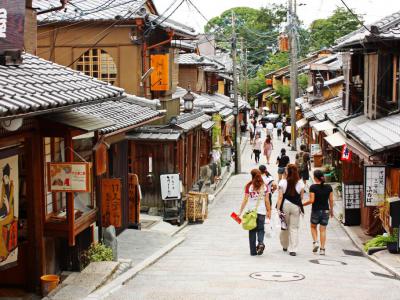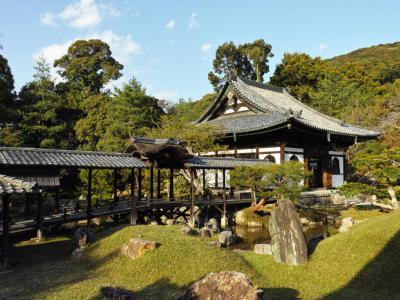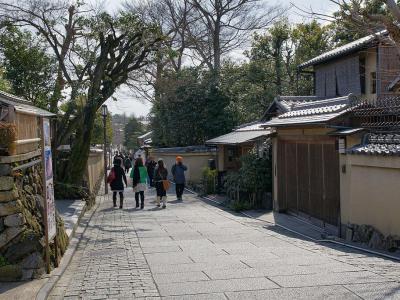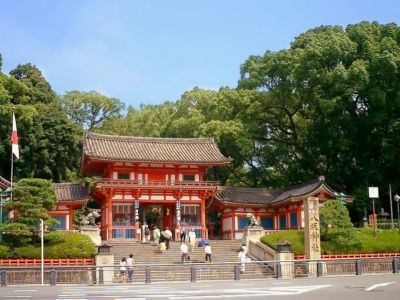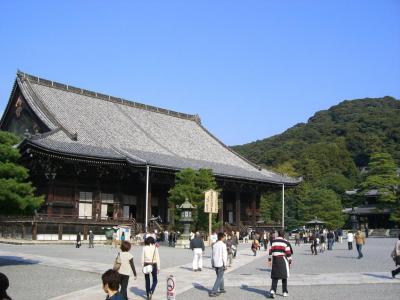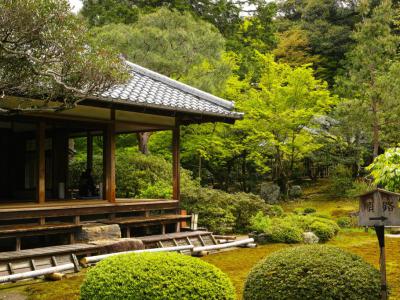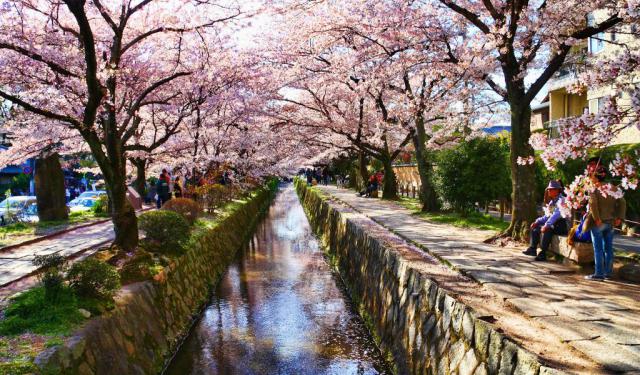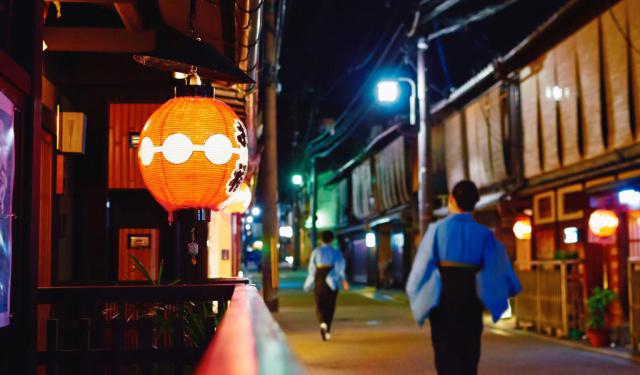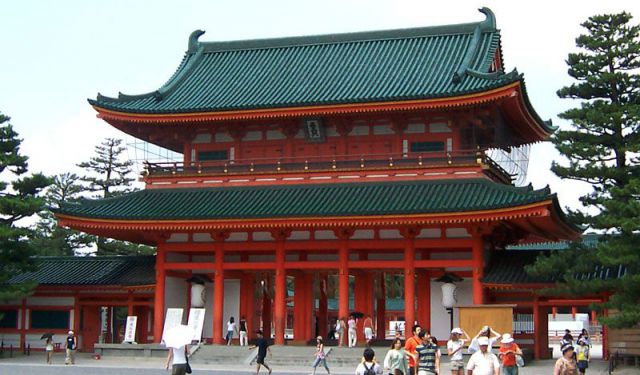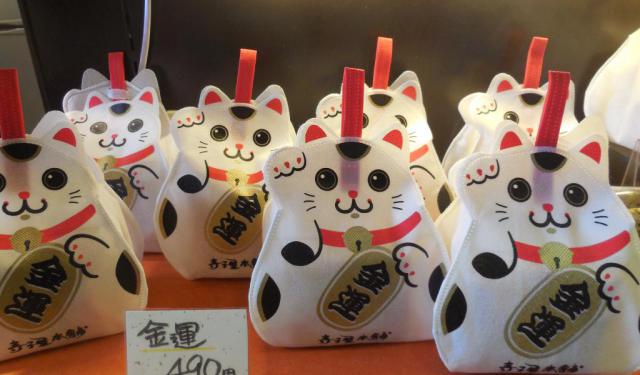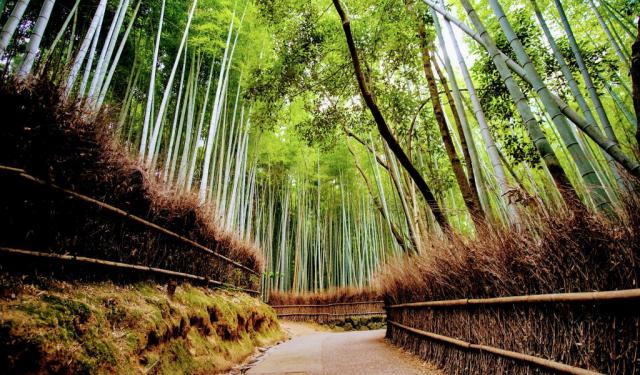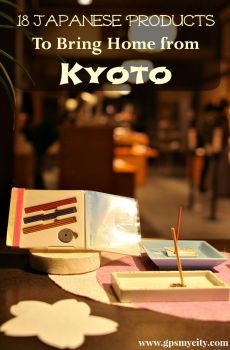Audio Guide: Higashiyama Walking Tour (Self Guided), Kyoto
It'd be fair to say that Kyoto is a theme park for lovers of history, religion, and all things deeply, unmistakably Japanese. If so, Higashiyama Ward, with its long lines, can easily be recognized as its star attraction. Tucked along the city’s eastern edge-hence its poetic name translated as “Eastern Mountain”-this district is where Kyoto flaunts its heritage like a geisha in full regalia. It’s a place where feudal-era Japan isn’t simply remembered but is very much alive and well, sipping tea in a machiya and contemplating cherry blossoms.
Back in the Heian period (between the 8th and 12th centuries), when Kyoto was the imperial capital and the world still ran on scrolls and sandalwood, Higashiyama was already establishing itself as a cultural hotspot. A few centuries later, the area hit its stride during the Muromachi and Edo periods (from 1336 to 1868), blossoming into a religious and artistic haven. Toyotomi Hideyoshi-the warlord, unifier, and part-time city planner-gave the neighborhood a dramatic facelift in the late 16th century, commissioning impressive structures that still earn architectural bragging rights even today.
By the 1600s, Higashiyama had firmly established its aesthetic in cozy alleys, slatted wood townhouses, and an eerie ability to make visitors forget what century they’re in. It's like Kyoto's version of a historical time capsule-except you can walk through it while eating matcha ice cream. The district continues to charm with landmarks like Kiyomizu-dera Temple, perched dramatically atop a hillside, and the winding streets of Ninen-zaka and Sannen-zaka, where even the souvenir shops feel timeless.
For a deeper spiritual dive, there’s Kodai-ji sanctuary with its Zen gardens, Nene-no-Michi Lane for those seeking quiet teahouse vibes, and big-hitters like Yasaka-jinja Shrine and Chion-in Temple, both equally impressive in ritual and scale. And if you’re craving something more low-key, Shoren-in Temple offers palace architecture and a light show in spring and fall. In Higashiyama, history doesn’t whisper-it chants, dances, and hands you a rice cracker on the way... Enjoy it!
Back in the Heian period (between the 8th and 12th centuries), when Kyoto was the imperial capital and the world still ran on scrolls and sandalwood, Higashiyama was already establishing itself as a cultural hotspot. A few centuries later, the area hit its stride during the Muromachi and Edo periods (from 1336 to 1868), blossoming into a religious and artistic haven. Toyotomi Hideyoshi-the warlord, unifier, and part-time city planner-gave the neighborhood a dramatic facelift in the late 16th century, commissioning impressive structures that still earn architectural bragging rights even today.
By the 1600s, Higashiyama had firmly established its aesthetic in cozy alleys, slatted wood townhouses, and an eerie ability to make visitors forget what century they’re in. It's like Kyoto's version of a historical time capsule-except you can walk through it while eating matcha ice cream. The district continues to charm with landmarks like Kiyomizu-dera Temple, perched dramatically atop a hillside, and the winding streets of Ninen-zaka and Sannen-zaka, where even the souvenir shops feel timeless.
For a deeper spiritual dive, there’s Kodai-ji sanctuary with its Zen gardens, Nene-no-Michi Lane for those seeking quiet teahouse vibes, and big-hitters like Yasaka-jinja Shrine and Chion-in Temple, both equally impressive in ritual and scale. And if you’re craving something more low-key, Shoren-in Temple offers palace architecture and a light show in spring and fall. In Higashiyama, history doesn’t whisper-it chants, dances, and hands you a rice cracker on the way... Enjoy it!
How it works: Download the app "GPSmyCity: Walks in 1K+ Cities" from Apple App Store or Google Play Store to your mobile phone or tablet. The app turns your mobile device into a personal tour guide and its built-in GPS navigation functions guide you from one tour stop to next. The app works offline, so no data plan is needed when traveling abroad.
Higashiyama Walking Tour Map
Guide Name: Higashiyama Walking Tour
Guide Location: Japan » Kyoto (See other walking tours in Kyoto)
Guide Type: Self-guided Walking Tour (Sightseeing)
# of Attractions: 7
Tour Duration: 1 Hour(s)
Travel Distance: 2.6 Km or 1.6 Miles
Author: emma
Sight(s) Featured in This Guide:
Guide Location: Japan » Kyoto (See other walking tours in Kyoto)
Guide Type: Self-guided Walking Tour (Sightseeing)
# of Attractions: 7
Tour Duration: 1 Hour(s)
Travel Distance: 2.6 Km or 1.6 Miles
Author: emma
Sight(s) Featured in This Guide:
- Kiyomizu-dera Temple
- Ninen-zaka & Sannen-zakaa Streets
- Kodai-ji Temple
- Nene-no-Michi Lane
- Yasaka-jinja Shrine
- Chion-in Temple
- Shoren-in Temple
1) Kiyomizu-dera Temple (must see)
Towering above the treasure-packed sprawl of Southern Higashiyama, Kiyomizu-dera temple is both a place of worship and Kyoto’s dramatic headliner. Equal parts spiritual retreat and bucket-list selfie spot, it offers sweeping views of the city below (if you can peel your eyes away from the throngs of visitors doing the same). And should you be bold enough (or just patient) to visit during cherry blossom season, the nighttime glow of illuminated petals will be your reward for enduring the human traffic jam.
The temple’s story starts with a splash-quite literally. In 778, a monk named Enchin Shonin, nudged by a divine vision, stumbled upon the Otowa Spring. The water was so pure that it gave the temple its name: Kiyomizu, meaning “clear water.” A noble patron, moved by the miracle (or just in the mood for grand gestures), commissioned a hall built not in typical temple fashion but in the style of an aristocrat’s dream home-complete with a swooping shingled roof. At its heart is a rarely-seen 1,000-armed Kannon (a bodhisattva of compassion, widely revered in East Asian Buddhism, especially in Japan), which is unveiled to mere mortals once every 33 years. Blink and you’ll miss it... for another three decades.
Then there’s the famous stage-no nails, just massive wooden pillars holding up a 13-meter (or 43-foot) drop. Originally used for sacred dance performances, it later gained ill fame as a tragic endpoint for desperate folks hoping to leap their way into a better afterlife. Nowadays, you’re more likely to leap into a photo op with Kyoto’s hills in the background.
Wander a bit more and you'll find Jishu Shrine, matchmaking central, and the pagoda where expectant mothers whisper hopes for safe births. And don’t skip the Otowa Spring, of course: its three trickling streams promise health, longevity, or academic success. Just pick one-greedy sipping is frowned upon. After 1,200 years, the lines are still long and the stakes still high. So, choose wisely...
The temple’s story starts with a splash-quite literally. In 778, a monk named Enchin Shonin, nudged by a divine vision, stumbled upon the Otowa Spring. The water was so pure that it gave the temple its name: Kiyomizu, meaning “clear water.” A noble patron, moved by the miracle (or just in the mood for grand gestures), commissioned a hall built not in typical temple fashion but in the style of an aristocrat’s dream home-complete with a swooping shingled roof. At its heart is a rarely-seen 1,000-armed Kannon (a bodhisattva of compassion, widely revered in East Asian Buddhism, especially in Japan), which is unveiled to mere mortals once every 33 years. Blink and you’ll miss it... for another three decades.
Then there’s the famous stage-no nails, just massive wooden pillars holding up a 13-meter (or 43-foot) drop. Originally used for sacred dance performances, it later gained ill fame as a tragic endpoint for desperate folks hoping to leap their way into a better afterlife. Nowadays, you’re more likely to leap into a photo op with Kyoto’s hills in the background.
Wander a bit more and you'll find Jishu Shrine, matchmaking central, and the pagoda where expectant mothers whisper hopes for safe births. And don’t skip the Otowa Spring, of course: its three trickling streams promise health, longevity, or academic success. Just pick one-greedy sipping is frowned upon. After 1,200 years, the lines are still long and the stakes still high. So, choose wisely...
2) Ninen-zaka & Sannen-zakaa Streets (must see)
If you ever thought that time-travel on foot is not possible, welcome to Ninen-zaka and Sannen-zaka, Kyoto’s prettiest pair of gently sloping stone-paved streets. Just south of the famous Kiyomizu-dera Temple, these twin time capsules have been charming pilgrims, poets, and now Instagrammers since the Heian period (as far back as the 8th century AD). Their names-translating to “Two-Year Hill” and “Three-Year Hill,” respectively-aren’t just quaint poetry; legend has it that if you trip here, you’ll be cursed with two or three years of bad luck. So watch your step, but do it stylishly...
Lined with wooden machiya townhouses straight out of an Edo-era painting, these streets now brim with modern temptations in historical disguise-such as matcha lattes in teahouses, delicate sweets that look too pretty to eat, and souvenir shops where even the magnets feel refined. Early mornings bring soft golden light and far fewer tourists-ideal for catching that postcard-perfect shot of Yasaka Pagoda or wandering down a lantern-lit alley like a wandering extra in a samurai drama.
No cars, no chaos-just the click-clack of wooden geta sandals on stone and the scent of roasted tea in the air. It’s like Kyoto whispered, “Slow down,” and these hills listened. For a walk that’s part history lesson, part sensory feast, and 100% Kyoto, Ninen-zaka and Sannen-zaka are more than just pathways-they’re an experience with a side of superstition...
Lined with wooden machiya townhouses straight out of an Edo-era painting, these streets now brim with modern temptations in historical disguise-such as matcha lattes in teahouses, delicate sweets that look too pretty to eat, and souvenir shops where even the magnets feel refined. Early mornings bring soft golden light and far fewer tourists-ideal for catching that postcard-perfect shot of Yasaka Pagoda or wandering down a lantern-lit alley like a wandering extra in a samurai drama.
No cars, no chaos-just the click-clack of wooden geta sandals on stone and the scent of roasted tea in the air. It’s like Kyoto whispered, “Slow down,” and these hills listened. For a walk that’s part history lesson, part sensory feast, and 100% Kyoto, Ninen-zaka and Sannen-zaka are more than just pathways-they’re an experience with a side of superstition...
3) Kodai-ji Temple
Kodai-ji Temple-by far not an average run-of-the-mill Zen sanctuary-is indeed more like a glam-packed cultural treasure chest. It was curated by Japan’s most legendary widow-turned-nun, Nene, after her powerful husband, Toyotomi Hideyoshi, shuffled off this mortal coil in 1598. Nene planned her getaway and was fortunate to receive some major patronage from the new shogun. The result was a temple so dripping with style that even the Buddha would raise an eyebrow.
The temple's dry landscape garden that morphs into different designs throughout the year will have you scratching your head like a Zen master pondering a puzzling, moody Zen riddle in motion. But before you set foot in the gardens, brace yourself for an eyeful indoors. Here, you’re greeted not with silence, but with visual poetry. The painted 'fusuma' (those cute sliding screens) appear like scrolls that seem to have forgotten how to stop being dramatic.
Still, the real magic kicks in outdoors. Once you reach the gardens, prepare for a serious sensory overload. The upper and lower ponds are like nature's own Instagram filters, reflecting cherry blossoms or maple leaves in a dance of color and light. As you wander up the garden path, you'll stumble upon a memorial hall for Hideyoshi and Nene, while Hideyoshi's love for tea is on full display with two historical tea houses at the top of the hill. On your way back, don't miss the bamboo grove and the jaw-dropping Ryozen Kannon statue, standing tall as a war memorial since 1955.
Nearby, you'll find Kodai-ji’s quieter sibling, the subtemple of Entoku-in, where Nene spent her golden years. It may be smaller in scale, but it's big on elegance, with narrow corridors and lovely fusuma paintings, and (the cherry on top!) the best seat in town for sipping green tea in front of one of Japan's most dynamic rock gardens. It practically hums with serenity, ready to soothe your soul after a day of temple-hopping.
Indeed, Kodai-ji is an experience in layered nostalgia, zen landscaping, and imperial intrigue. And while you're at it, you can take a stroll around the neighboring street to soak up Kyoto's timeless atmosphere.
Hot tip:
Your ticket includes a tiny museum downhill, so don't miss it! And yes, there are many, many stairs to climb, so be prepared. But then again, you can think of it as your daily workout with a side of enlightenment...
The temple's dry landscape garden that morphs into different designs throughout the year will have you scratching your head like a Zen master pondering a puzzling, moody Zen riddle in motion. But before you set foot in the gardens, brace yourself for an eyeful indoors. Here, you’re greeted not with silence, but with visual poetry. The painted 'fusuma' (those cute sliding screens) appear like scrolls that seem to have forgotten how to stop being dramatic.
Still, the real magic kicks in outdoors. Once you reach the gardens, prepare for a serious sensory overload. The upper and lower ponds are like nature's own Instagram filters, reflecting cherry blossoms or maple leaves in a dance of color and light. As you wander up the garden path, you'll stumble upon a memorial hall for Hideyoshi and Nene, while Hideyoshi's love for tea is on full display with two historical tea houses at the top of the hill. On your way back, don't miss the bamboo grove and the jaw-dropping Ryozen Kannon statue, standing tall as a war memorial since 1955.
Nearby, you'll find Kodai-ji’s quieter sibling, the subtemple of Entoku-in, where Nene spent her golden years. It may be smaller in scale, but it's big on elegance, with narrow corridors and lovely fusuma paintings, and (the cherry on top!) the best seat in town for sipping green tea in front of one of Japan's most dynamic rock gardens. It practically hums with serenity, ready to soothe your soul after a day of temple-hopping.
Indeed, Kodai-ji is an experience in layered nostalgia, zen landscaping, and imperial intrigue. And while you're at it, you can take a stroll around the neighboring street to soak up Kyoto's timeless atmosphere.
Hot tip:
Your ticket includes a tiny museum downhill, so don't miss it! And yes, there are many, many stairs to climb, so be prepared. But then again, you can think of it as your daily workout with a side of enlightenment...
4) Nene-no-Michi Lane
Meandering through the historic wonders of Southern Higashiyama, this scenic flagstone pathway connects key landmarks with the grace of a feudal lord's consort. Named after the refined wife of warlord Toyotomi Hideyoshi, this stone-paved tribute gently links the Ninen-zaka and Sannen-zaka lanes with iconic landmarks such as Kodai-ji Temple and Maruyama-koen Park. A kind of historical “red carpet” minus paparazzi, but with significantly more cherry blossoms...
While the occasional taxi or rogue rickshaw may attempt to navigate through the sea of wandering tourists, this lane is truly a pedestrian paradise primarily reserved for foot traffic. Especially in spring, during cherry blossom season, it offers an idyllic setting for leisurely strolls, when petals swirl through the air like confetti at a samurai wedding. And come evening, the tranquility is all yours to savor, away from the daytime buzz. The crowds thin, the lanterns flicker on, and you’ve got Kyoto at its most cinematic.
Just off the path, slip into Ishibe-koji alley-a postcard come to life, with rustic wooden homes leaning with age, traditional teahouses beckoning with warm light, and cozy ryokan inns whispering promises of tatami dreams-a true embodiment of "wabi-sabi" aesthetic philosophy, Kyoto-style, where imperfection exudes its own unique allure.
Venturing further along, don’t miss Gionkaku Tower near Daiun-in Temple-a curious little structure that looks like someone parked a Gion Festival float on temple grounds and forgot to take it home. Usually closed to the public, this towering structure opens its doors during summer. So, if you’re lucky to catch it open, get in and climb up for sweeping views. Just remember, no photos allowed!-Some secrets are better kept analog.
Pro tip:
As you stroll, be sure to snap a selfie at the signs and lanterns with a “Nene-no-Michi” inscription in Japanese for your Kyoto scrapbook. And don't hesitate to reach out and touch the Buddha statues hiding in plain sight along the way-especially the jolly, round-bellied Hotei. Pat his tummy. For good luck… because how can you possibly not?!
While the occasional taxi or rogue rickshaw may attempt to navigate through the sea of wandering tourists, this lane is truly a pedestrian paradise primarily reserved for foot traffic. Especially in spring, during cherry blossom season, it offers an idyllic setting for leisurely strolls, when petals swirl through the air like confetti at a samurai wedding. And come evening, the tranquility is all yours to savor, away from the daytime buzz. The crowds thin, the lanterns flicker on, and you’ve got Kyoto at its most cinematic.
Just off the path, slip into Ishibe-koji alley-a postcard come to life, with rustic wooden homes leaning with age, traditional teahouses beckoning with warm light, and cozy ryokan inns whispering promises of tatami dreams-a true embodiment of "wabi-sabi" aesthetic philosophy, Kyoto-style, where imperfection exudes its own unique allure.
Venturing further along, don’t miss Gionkaku Tower near Daiun-in Temple-a curious little structure that looks like someone parked a Gion Festival float on temple grounds and forgot to take it home. Usually closed to the public, this towering structure opens its doors during summer. So, if you’re lucky to catch it open, get in and climb up for sweeping views. Just remember, no photos allowed!-Some secrets are better kept analog.
Pro tip:
As you stroll, be sure to snap a selfie at the signs and lanterns with a “Nene-no-Michi” inscription in Japanese for your Kyoto scrapbook. And don't hesitate to reach out and touch the Buddha statues hiding in plain sight along the way-especially the jolly, round-bellied Hotei. Pat his tummy. For good luck… because how can you possibly not?!
5) Yasaka-jinja Shrine
At the eastern edge of Gion's main street looms a towering vermilion gate that practically begs to be photographed. And judging by the steady stream of visitors posing on its steps for countless snapshots, it surely gets its wish.
Passing through, you’re in for a sensory parade: food stalls sizzling away, tempting you with every imaginable treat as they lead you toward the heart of the scene-Yasaka Shrine. A triple row of lanterns, casting a glow, transforms it into a fairy tale come to life.
Each July, Yasaka Shrine takes center stage as the proud host of the renowned Gion Festival, a lively spectacle drawing throngs of revelers with its array of side events and delectable food offerings. At this time, the area bursts to life with floats, fanfare, and enough street snacks to feed a small army of festivalgoers.
The festival's roots trace back to the year 869. Back then, during a particularly rough epidemic, portable shrines were paraded around town in a divine plea for mercy. Centuries since, it has blossomed into an annual event, yet Yasaka Shrine remains a captivating destination year-round, beyond the festival fervor. Still, nowadays, most of the crowds here are for the energy, the lanterns, and yes, the Instagram shots.
Take a moment to admire the Main Hall, elegantly capped with a cypress bark roof that’s been standing strong since 1654. The grounds are dotted with smaller shrines dedicated to gods from across Japan-some famous, some niche, and one especially popular with geishas, thanks to its focus on beauty.
Tip:
Adjacent lies Maruyama Park. Designed during the Meiji era (between 1868 and 1912), its borrowed waters from Lake Biwa feed scenic carp ponds and arching bridges that deliver peak postcard material, imbuing the surroundings with an unmistakably Japanese ambiance. Springtime is wild with cherry blossoms, but for a quieter moment, come at night-when the lantern glow from Yasaka spills into the park like a soft whisper from the past...
Passing through, you’re in for a sensory parade: food stalls sizzling away, tempting you with every imaginable treat as they lead you toward the heart of the scene-Yasaka Shrine. A triple row of lanterns, casting a glow, transforms it into a fairy tale come to life.
Each July, Yasaka Shrine takes center stage as the proud host of the renowned Gion Festival, a lively spectacle drawing throngs of revelers with its array of side events and delectable food offerings. At this time, the area bursts to life with floats, fanfare, and enough street snacks to feed a small army of festivalgoers.
The festival's roots trace back to the year 869. Back then, during a particularly rough epidemic, portable shrines were paraded around town in a divine plea for mercy. Centuries since, it has blossomed into an annual event, yet Yasaka Shrine remains a captivating destination year-round, beyond the festival fervor. Still, nowadays, most of the crowds here are for the energy, the lanterns, and yes, the Instagram shots.
Take a moment to admire the Main Hall, elegantly capped with a cypress bark roof that’s been standing strong since 1654. The grounds are dotted with smaller shrines dedicated to gods from across Japan-some famous, some niche, and one especially popular with geishas, thanks to its focus on beauty.
Tip:
Adjacent lies Maruyama Park. Designed during the Meiji era (between 1868 and 1912), its borrowed waters from Lake Biwa feed scenic carp ponds and arching bridges that deliver peak postcard material, imbuing the surroundings with an unmistakably Japanese ambiance. Springtime is wild with cherry blossoms, but for a quieter moment, come at night-when the lantern glow from Yasaka spills into the park like a soft whisper from the past...
6) Chion-in Temple
A brisk eight-minute stroll from Kodai-ji temple-just north of Yasaka-jinja and the leafy calm of Maruyama Park-looms another temple, so massive it’s been colloquially dubbed the “Vatican of Pure Land Buddhism.” Welcome to Chion-in, the head shrine of the Jodo sect, and a certified National Treasure of Japan. If you expect modesty here, don't!-This place rivals St. Peter’s in the Vatican in sheer scale (minus the Swiss Guards).
You may recognize the towering, monumental front staircase-it’s had its moment in Hollywood, making notable appearances in “The Last Samurai” and “Lost in Translation.” But don’t stop there; the true marvel awaits at the impressive Sanmon gate. An unparalleled all-wooden display of joinery, it stands 24 meters high and 50 meters wide and proudly holds the title of Japan’s largest wooden gate.
Past the gate lies the temple’s spiritual core, a sprawling courtyard crisscrossed by intricate stone pathways. The Main Hall welcomes everyone with its free admission and houses a commanding statue of Honen, the revered priest and the founding figure of the Jodo sect. Wander a bit farther and you’ll come to the Amida Hall, home to a serene depiction of Amida Buddha, the central figure in Pure Land Buddhism. For the rest of the grounds, you'll need a ticket-but it’s well worth it.
Pro tip: Hidden just off the beaten path are two garden gems. Yūzen-en, a serene rock garden with a tranquil pond, graces the southeast of the Sanmon gate, while Hojo-en, a timeless landscape garden dating back to the mid-17th century, lies east of the Main Hall. For an immersive experience, visitors can opt to explore both gardens (which are open until 4 PM) at a discounted price, because enlightenment always comes with a good deal...
You may recognize the towering, monumental front staircase-it’s had its moment in Hollywood, making notable appearances in “The Last Samurai” and “Lost in Translation.” But don’t stop there; the true marvel awaits at the impressive Sanmon gate. An unparalleled all-wooden display of joinery, it stands 24 meters high and 50 meters wide and proudly holds the title of Japan’s largest wooden gate.
Past the gate lies the temple’s spiritual core, a sprawling courtyard crisscrossed by intricate stone pathways. The Main Hall welcomes everyone with its free admission and houses a commanding statue of Honen, the revered priest and the founding figure of the Jodo sect. Wander a bit farther and you’ll come to the Amida Hall, home to a serene depiction of Amida Buddha, the central figure in Pure Land Buddhism. For the rest of the grounds, you'll need a ticket-but it’s well worth it.
Pro tip: Hidden just off the beaten path are two garden gems. Yūzen-en, a serene rock garden with a tranquil pond, graces the southeast of the Sanmon gate, while Hojo-en, a timeless landscape garden dating back to the mid-17th century, lies east of the Main Hall. For an immersive experience, visitors can opt to explore both gardens (which are open until 4 PM) at a discounted price, because enlightenment always comes with a good deal...
7) Shoren-in Temple
If you need a break from the tourist stampede in Kyoto, Shoren-in might just be your secret hideout-less crowded, more enchanted. Once an imperial residence and run by monks with royal blood, this temple's palatial architecture still exudes the quiet elegance of old aristocracy.
As you enter, you'll be greeted by a grove of ancient camphor trees that have been standing here for over 700 years. Inside the Kacho-den hall, you’ll find lotus blossoms blooming across the walls and portraits of the legendary 36 Immortal Poets giving you the silent treatment. Then, there’s the massive tatami room-ideal for unwinding while soaking in a picture-perfect pond garden designed by the master artist Soami, Kyoto’s own 16th-century landscaping guru. With a moss garden, dry landscape garden, and azalea garden also on offer, this is, indeed, a paradise for garden lovers.
Follow the covered walkways (reminiscent of Heian-era palaces) and you’ll reach the main hall, featuring, instead of your usual Buddha statue, a rather unusual object of worship: a glowing mandala, holding center stage. Around the corner is the Kobun-tei tea house, lovingly rebuilt after a 1993 fire, now home to delicate art by Uemura Atsushi, a Kyoto native painter renowned for his depictions of birds and flowers.
And when spring or autumn hits, Shoren-in goes full showtime, becoming the “Vegas of temples” with its dazzling illuminations. Thanks to its patron deity, Shijoko Nyorai, the god of light, the temple transforms into a luminous dreamscape. Illuminations ripple through the gardens like sacred electricity-turning this peaceful haven into one of Kyoto’s most surreal night spectacles.
As you enter, you'll be greeted by a grove of ancient camphor trees that have been standing here for over 700 years. Inside the Kacho-den hall, you’ll find lotus blossoms blooming across the walls and portraits of the legendary 36 Immortal Poets giving you the silent treatment. Then, there’s the massive tatami room-ideal for unwinding while soaking in a picture-perfect pond garden designed by the master artist Soami, Kyoto’s own 16th-century landscaping guru. With a moss garden, dry landscape garden, and azalea garden also on offer, this is, indeed, a paradise for garden lovers.
Follow the covered walkways (reminiscent of Heian-era palaces) and you’ll reach the main hall, featuring, instead of your usual Buddha statue, a rather unusual object of worship: a glowing mandala, holding center stage. Around the corner is the Kobun-tei tea house, lovingly rebuilt after a 1993 fire, now home to delicate art by Uemura Atsushi, a Kyoto native painter renowned for his depictions of birds and flowers.
And when spring or autumn hits, Shoren-in goes full showtime, becoming the “Vegas of temples” with its dazzling illuminations. Thanks to its patron deity, Shijoko Nyorai, the god of light, the temple transforms into a luminous dreamscape. Illuminations ripple through the gardens like sacred electricity-turning this peaceful haven into one of Kyoto’s most surreal night spectacles.
Walking Tours in Kyoto, Japan
Create Your Own Walk in Kyoto
Creating your own self-guided walk in Kyoto is easy and fun. Choose the city attractions that you want to see and a walk route map will be created just for you. You can even set your hotel as the start point of the walk.
Walk on Philosopher's Path
Looking for a scenic walk with a side of existential pondering in Kyoto, you're inevitably bound to end up on the Philosopher’s Path. Winding its way for about two kilometers along the leafy canal that carries water from Lake Biwa to the foothills, this picturesque walking trail once served as the thinking route of Nishida Kitaro. Back in the first half of the 20th century, the famed... view more
Tour Duration: 2 Hour(s)
Travel Distance: 2.6 Km or 1.6 Miles
Tour Duration: 2 Hour(s)
Travel Distance: 2.6 Km or 1.6 Miles
Gion District Walking Tour
Gion, one of Kyoto’s most captivating districts, is deeply rooted in Japan’s cultural heritage. Located in the Higashiyama (the so-called “Eastern Mountain”) neighborhood, its history dates back to the Sengoku period, when it began as a hospitality area for pilgrims visiting Yasaka Shrine. By the late 18th and early 19th centuries, it had evolved into a renowned entertainment quarter,... view more
Tour Duration: 2 Hour(s)
Travel Distance: 2.8 Km or 1.7 Miles
Tour Duration: 2 Hour(s)
Travel Distance: 2.8 Km or 1.7 Miles
Imperial Kyoto Walking Tour
Kyoto served as Japan’s imperial capital for over 1,000 years, from 794 to 1869, beginning with Emperor Kanmu’s relocation of his court to Heian-kyō (which is Kyoto’s former name). Though political power eventually shifted to the shogunate and later to Tokyo, Kyoto remained the cultural and symbolic heart of Japan. Its long association with the imperial court helped shape it into a refined... view more
Tour Duration: 2 Hour(s)
Travel Distance: 4.1 Km or 2.5 Miles
Tour Duration: 2 Hour(s)
Travel Distance: 4.1 Km or 2.5 Miles
Kyoto Shopping and Food Tour
The cultural capital of Japan, Kyoto is just as famous as a shopper’s paradise and, without a doubt, the best place in the country to buy traditional and modern Japanese goods. Souvenirs, food, bargains, and various “one-of-a-kind items” are all up for grabs here.
In addition to its shopping scene, Kyoto boasts a rich culinary heritage, from Michelin-starred restaurants to humble street... view more
Tour Duration: 1 Hour(s)
Travel Distance: 2.0 Km or 1.2 Miles
In addition to its shopping scene, Kyoto boasts a rich culinary heritage, from Michelin-starred restaurants to humble street... view more
Tour Duration: 1 Hour(s)
Travel Distance: 2.0 Km or 1.2 Miles
Arashiyama and Bamboo Grove Walking Tour
The Arashiyama district of Kyoto is slightly out of the way for tourists, but that means you can enjoy it more comfortably.
Undoubtedly, the most popular attraction here is the iconic Bamboo Grove, a mesmerizing forest of towering bamboo stalks that sway gently in the breeze, creating an ethereal atmosphere. This serene setting is a must-visit for travelers seeking tranquility amidst... view more
Tour Duration: 2 Hour(s)
Travel Distance: 3.4 Km or 2.1 Miles
Undoubtedly, the most popular attraction here is the iconic Bamboo Grove, a mesmerizing forest of towering bamboo stalks that sway gently in the breeze, creating an ethereal atmosphere. This serene setting is a must-visit for travelers seeking tranquility amidst... view more
Tour Duration: 2 Hour(s)
Travel Distance: 3.4 Km or 2.1 Miles
Useful Travel Guides for Planning Your Trip
18 Japanese Products To Bring Home from Kyoto
The old capital of Japan, the city of Kyoto has once again been the talk of the world lately, thanks to the bestselling "Memoirs of a Geisha" book and the namesake Hollywood blockbuster movie. Renowned for its impeccable craftsmanship, Japan has so much to amaze a foreign eye with. Many of...
The Most Popular Cities
/ view all
